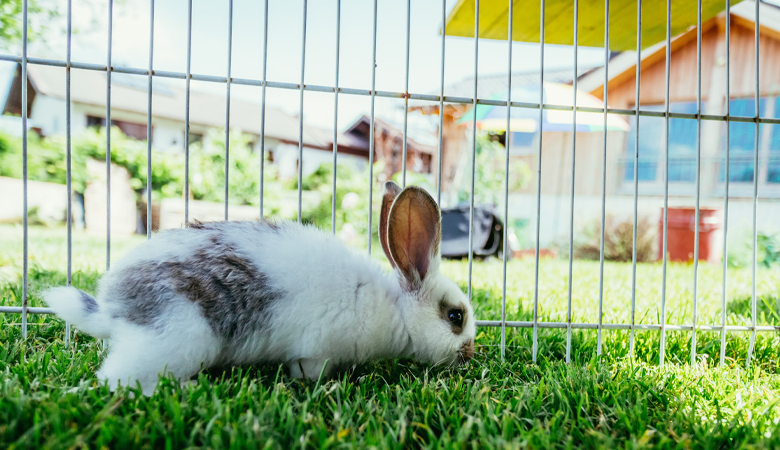Keeping a pet rabbit
Written by |
Rabbits (Oryctolagus cuniculus) are mammals, belonging to the lagomorph family (hares and rabbits). Rabbits are not rodents, although they are often thought to be. In this article, we will look at what it takes to keep a pet rabbit.

Rabbits (Oryctolagus cuniculus) are mammals, belonging to the lagomorph family (hares and rabbits). Rabbits are not rodents, although they are often thought to be. In this article, we will look at what it takes to keep a pet rabbit.
Rabbit vs rodent
Rodents only have two incisors in the top part of their mouths, while rabbits and hares have four, including two peg teeth behind the top incisors. Rabbits and hares are the only species that have these two peg teeth. Rabbits were domesticated as early as Roman times. First the animals were kept for their meat and coats, and later as pets.
Lifestyle
Rabbits are herd animals. They do not like to live alone, so we recommend that you keep rabbits together in a big enough hutch. A male and female are usually the best combination. In this case, at least the male will have to be castrated in order to avoid having young. In addition, we would also advise you to spay the female in order to prevent uterine problems at a later age. Two uncastrated males will practically always fight when they get older. When you have two females that have not been spayed, the animals will also often start fighting suddenly when they reach maturity as a result of hormones. Two castrated or spayed rabbits of the same sex can sometimes live together provided that they have known each other from a young age and have enough space. Never just put two adult rabbits together if they do not know each other, as they can hurt each other badly.
Roughage, vegetables and pellets
Rabbits are herbivores and need plenty of fibre. Roughage, such as hay, consists mainly of fibre. This is why you should give your rabbit unlimited amounts of hay every day. Straw also contains plenty of fibre, but has a lower nutritional value. The grass and vegetables also contain fibre, allow your rabbit to get used to these slowly in order to prevent diarrhoea. Not every vegetable is suitable, as cruciferous and gas-causing vegetables such as cabbage, leek and the like can make your rabbit very ill. Chicory, endives, carrot greens, radish leaf or pieces of carrot can be fed to rabbits. Please ensure that your rabbit gets used to these foods gradually. Fruit and dry bread may be tasty, but they also lead to obesity in your pet. In addition, they contain many sugars that cannot be properly processed by the gastrointestinal system. The healthiest thing is to give hay and pellets. At Vetsend.co.uk, we offer products including food from Supreme Science Selective. A major advantage of this uniform food is that the rabbit receives all of the nutrients in the right proportions. However, when giving a mixed food, rabbits will often selectively eat what they like and they therefore do not get all of the required nutrients.
Quantity
An adult rabbit needs approximately 20 grams of food per kg of body weight. Restrict the food to this quantity in order to prevent obesity. An active outdoor rabbit needs more food than a calm rabbit that mainly stays in its hutch. If necessary, weigh the rabbit in order to keep an eye on its weight. Rabbits reingests part of their faeces, the so-called cecotropes, directly from the anus. This phenomenon is called Coprofragy. These faeces contain vital nutrients. If you find these soft, shiny bunches of faeces in your rabbit’s hutch regularly, then there is a good chance that you are overfeeding your rabbit.
Extra fibre and water
Rabbits enjoy chewing on sticks such as willow branches. This gives them something to do, it is good for their teeth and provides extra fibre. Do not give your rabbit a pumice stone for chewing, as these contain excessive amounts of lime and can cause bladder stones. Rabbits must have access to unlimited amounts of fresh water. You can make this available in a drinking bottle or in a solid stone bowl.
Hutch enrichment
It is important for your pet’s wellbeing that you enrich your rabbit’s hutch to offer it mental challenges. These may include an interactive feeding game. You can find these products in our category toys for rabbits.
Most common conditions in rabbits
An important indication of your rabbit’s health is in its faeces. If they are small and hard, this indicates a risk of constipation or a lack of food. Faeces that are too soft and wet indicate bowel problems. This is often caused by the wrong nutrition. Other health problems, such as overgrown teeth (excessively long teeth) and obesity, can be prevented by feeding your rabbit responsibly and giving it plenty of roughage.
Rabbits are at risk of two dangerous and contagious diseases: myxomatosis and VHD (Viral Haemorrhagic Disease). These diseases are nearly always deadly. This is why you must have your rabbits immunised for these diseases annually. Female rabbits are at a fairly high risk of uterine cancer or infections later in life. These problems can be prevented by having feeders sterilised, preferably around the age of 6 months. If your rabbit is sick or you suspect that it is sick, always consult with your veterinarian. If your rabbit doesn’t eat or produce faeces, take it to the vet the same day. If you wait too long, your pet could die, and treatment is practically always needed.



